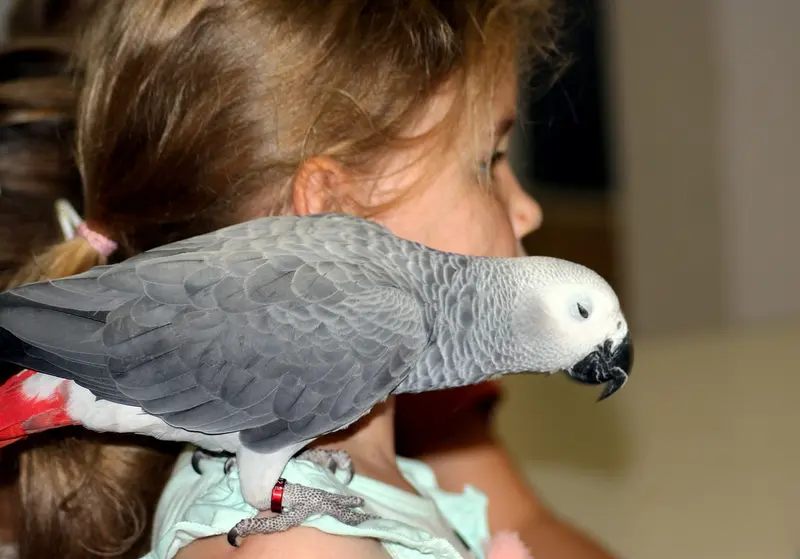Zebra parrots, with their mesmerizing, reflective eyes and ability to mimic human speech, have fascinated animal lovers around the world for years. These African beauties, though often associated with cozy home corners, hide a wild soul and mystery that is hard to resist. But have you ever wondered what lies behind their communication skills? Is their intelligence limited only to mimicking sounds, or do they go deeper, into areas we have yet to discover? In this article, we’ll delve into the fascinating world of the żako, uncovering their secrets, needs and what really makes them one of the most remarkable birds on the planet.
Introduction to the Zako parrot
Zookos are some of the most fascinating creatures in the bird world. Their unique character, their ability to mimic human speech, and their deep, reflective eyes have attracted the attention of breeders and ordinary animal lovers alike for years. These African beauties, although often associated with domestic settings, have a wild soul and mystery that is not to be missed.
Although parrots are popular as pets, many people are unaware of their deep intelligence and complexity. These birds can not only mimic sounds, but also understand and absorb new information, making them some of the most intelligent birds in the world. Their communication skills and perceptiveness often surprise even experienced keepers.
However, behind these abilities is also a sensitive creature that needs care, attention and understanding. Caring for a żako is not just a matter of feeding and cleaning the cage, but, above all, building a relationship based on mutual respect and trust. In the remainder of this article we will take a closer look at this remarkable species and discover what really makes them so special.
Characteristics and appearance of the Zako
Zookeeper parrots are easily recognizable by their impressive size and distinctive ash coloration. They have a strong, curved beak that is an excellent tool for breaking hard nuts and seeds. Their eyes are surrounded by white, almost naked skin, which adds definition and depth to their appearance. Body length can reach up to 40 centimeters, making them one of the largest breeding parrots.
One of the most distinctive elements of the żako’s appearance is their bright red tail. It contrasts beautifully with the ashen plumage, adding elegance and distinctiveness to the bird. The legs are strong and end in four toes – two pointing forward and two pointing backward, allowing them to grasp branches and various objects with confidence. Their silhouette, combined with their expressive appearance and confident movements, make them truly impressive and memorable birds at first glance.
Intelligence and communication skills of the Zako parrot
Zookeeper parrots are extremely intelligent birds that are often compared to young children in terms of their cognitive abilities. Studies have shown that they can not only understand human speech, but also solve complex puzzles and problems. Their ability to absorb new information and learn through observation is truly impressive. In many scientific experiments, these parrots have demonstrated the ability to understand abstract concepts such as shape, color and number.
Zako’s communication abilities:
- Imitating sounds: Zookeepers are masters at imitating a variety of sounds, from phone rings to household noises.
- Speech: They can learn many words and phrases in the human language, and some can even use them in the right context.
- Non-verbal communication: Through various body postures and vocal signals, these parrots can communicate their needs, feelings and intentions.
- Social interaction: When interacting with people and other birds, Zookos use their communication skills to establish relationships and build bonds.
The importance of communication for the Zookos
For żako parrots, communication is key to understanding their environment and interacting with it. With their communication skills, they are able to relate to people, learn from them and adapt to a variety of situations. In captivity, where these parrots often spend time in close contact with people, their communication skills play a key role in building mutual trust and understanding. Therefore, for owners of these birds, understanding and appreciating their communication skills is essential to ensure a happy and healthy life.
Diet and nutrition of the Zookeeper
Proper nutrition is key to the health and longevity of any body, and these parrots are no exception. As highly metabolized birds, they need a varied and nutrient-rich diet to ensure their energy and health. In the wild, their diet consists mainly of nuts, seeds, fruits and plants. In captivity, it is important to provide them with food that mimics their natural dietary preferences, while making sure they are balanced and full of essential nutrients.
Basic ingredients in the diet of Zookos:
- Seeds and nuts: They are the main component of a żako’s diet, providing fats and protein.
- Fresh fruits and vegetables: They are a source of vitamins, minerals and fiber. It is important that they are varied and fresh.
- Cereals: Such as millet or rice, they provide carbohydrates and energy.
- Animal protein: In the form of eggs or low-fat meat, provide essential amino acids.
- Calcium and minerals: Can be provided in the form of special pecking stones or supplements.
Challenges of a captive żako diet
Owners of żako parrots often face the challenge of providing them with an adequate diet at home. Although commercial parrot mixes are available, it is important that they are supplemented with fresh products and tailored to the bird’s individual needs. Over-reliance on one type of food can lead to nutritional deficiencies and health problems. Therefore, for the sake of their health, it is important to regularly monitor their diet and adjust it according to the bird’s needs and reactions.
Behavior and social interactions of the Zookeeper parrot
In their natural habitat, żako parrots are sociable birds that live in groups and maintain strong social bonds. They communicate with each other through a variety of sounds and visual signals, which are used to both express emotions and convey information. In captivity, the behavior of these parrots often reflects their social instincts. They are curious, active birds and often become attached to their keeper. However, without proper interaction and stimulation, they can become sad, stressed or even aggressive.
For frogs, social interaction is key to their mental well-being. In captivity, they need regular interaction with people or other birds. Without proper attention and stimulation, they can develop undesirable behaviors such as pecking, screaming or aggression. Owners of these birds should take the time to play, train and build a relationship with their żacos. In addition, providing them with toys, activities and opportunities for exploration can help meet their natural needs and prevent behavioral problems.

Breeding and reproduction of the Zako
Captive breeding of jacko parrots can be a challenge, but with the right care and conditions it is possible. It is important to provide them with a suitable nesting environment and take care of their needs during the breeding season. Females usually lay 3 to 5 eggs, which they brood for about 30 days. The young parrots leave the nest after about 12 weeks, although they continue to be fed by their parents for some time. For breeders, the key to success is to provide an adequate diet, a safe environment and monitor the birds’ health throughout the breeding process.
Zako parrot summary
Zookeeper parrots, with their incredible intelligence and communication skills, have become some of the most desirable companions among bird lovers. Their ability to mimic sounds, understand human speech and interact with their environment makes them unique in the bird world. However, like any animal, they need proper care, attention and understanding to fully develop their abilities and live life to the fullest.
Caring for the well-being of these parrots requires not only an understanding of their nutritional and health needs, but also their behavioral and social needs. Owners of these birds must be willing to devote time and energy to building a strong bond with them, providing them with the right environment, stimulation and care. Only then will jacko parrots be able to enjoy a long, healthy and happy life in captivity.
Frequently asked questions
The price of a żako parrot is about 2000,00 zloty – 4000,00 zloty. It is worth noting that prices can vary depending on the breeder, region and availability of specific species or varieties. Therefore, it is always advisable to get a thorough idea of prices and compare the offers of different breeders before making a purchase.
Zookos can become aggressive if they feel threatened or if they do not receive proper attention and care. It is important to treat them with respect and take care of their social needs.
In captivity, with proper care, żacos can live up to 20-30 years.
Like any bird, żacos require proper care, attention and understanding of their needs. They can be a challenge for novice breeders, but with the right knowledge and commitment they are wonderful companions.
Yes, geckos are known to mimic sounds, including human speech. They are among the best “talking” parrots.
Zookos need a varied diet consisting of high-quality parrot food, fresh fruits and vegetables and occasional treats.






